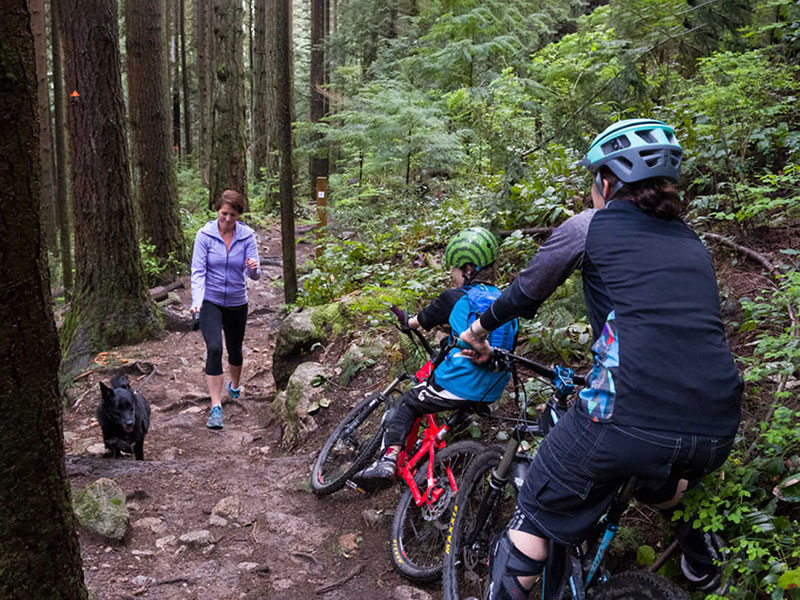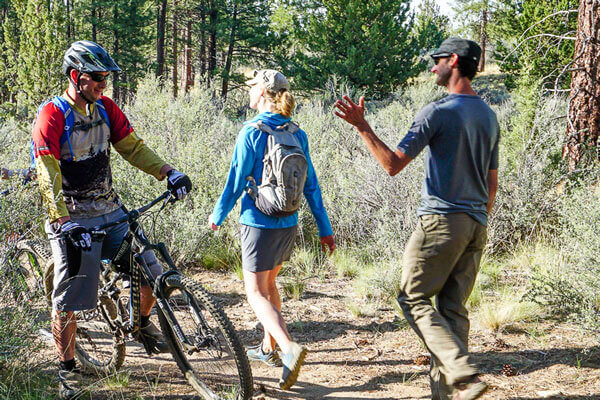What is a Shared-Use Trail?

A “shared-use” trail, also known as a “multi-use” trail, is a trail that is designed, intended, or used in practice by multiple user types, such as hikers, mountain bikers, horseback riders, hunters, skiers, or other users.
How common are shared-use trails?
Nearly all urban trails that allow mountain biking are shared with hikers—both in Wisconsin and nationwide. This shared use is the norm, as modern federal and state guidelines are based on the principle of accommodating multiple passive recreational users. Depending on the trail, it may also be accessible to other users like certain adaptive bikes or wheelchairs.
Can mountain bikers and hikers successfully use the same trail?
Yes! Even more narrow or “singletrack” trails can be used simultaneously by mountain bikers and hikers. These locations often deploy one or more techniques to ensure interactions between user groups are as positive as possible.

What techniques help bikers and hikers share the same trail?
There are many methods, approached using different aspects of the trail such as:
- The direction users go
- Trail width
- Speed control via trail design
- Signage
- Managing sightlines
- Trail etiquette
- Strategic interfaces with access points (parking lots, trailheads, etc.)
Together, these “User Management Techniques” create expectations for all types of users to keep on-trail interactions predictable and stress-free.
Will the proposed Evergreen Park trails be wide enough to safely share?
The majority of trail proposed is intended for, and would be designed to support, shared use for passive recreation users such as hiking and mountain biking. The trails would be natural surfaces and their widths would range from “singletrack” (<42″) to “track-and-a-half” (42″–60″). These are typical standard trail widths found in mountain bike projects across the nation. Trails may be strategically wider at key areas where user interaction is expected, or where a natural hazard is present.
Learn more on our Evergreen Trail Improvement project page.
References & Further Information:
- United States Forest Service – Trail Maintenance and Construction Notebook:
https://www.fs.usda.gov/sites/default/files/fs_media/fs_document/trail-maintenancenotebook.pdf - MN DNR, Parks and Trails Division, Trail Planning, Design, and Development Guidelines:
https://www.dnr.state.mn.us/publications/trails_waterways/tgmanual/index.html - American Trails – FAQ: What is the Typical Width of a Shared-Use Trail?:
https://www.americantrails.org/resources/what-is-the-typical-width-of-a-shared-use-trail - Jeff Marion and Jeremy Wimpey – Assessing The Influence of Sustainable Trail Design and Maintenance On Soil Loss (2017): https://pubs.usgs.gov/publication/70185163
- American Trails – Separate Trails Divide; Shared Trails Build Community:
https://www.americantrails.org/resources/separate-trails-divide-shared-trails-build-community - Duluth Parks & Recreation – Mountain Bike Trails: https://duluthmn.gov/parks/trailpages-list/mountain-bike-trails/
(Note: At time of access, showed that the largest intra-urban trail system in the nation shares singletrack trails.) - ORA Trails – Trails Page: https://www.oratrails.org/trails/ (Note: At time of access, showed that the largest Wisconsin intra-urban trail system shares singletrack trails, even in steep bluff terrain.)
- Dementyev, Fletcher, et al. (2023) Middle school cycling program is associated with improved mental health and wellbeing in adolescents during COVID-19:
https://www.frontiersin.org/journals/sports-and-activeliving/articles/10.3389/fspor.2023.1255514/full - Grapentin, Stephen, et al. (2018). How Soil, Flora and Fauna React To Mountain Bikers– An Overview of the Current State of Research. https://mountainbiketourismusforum.de/unterlagen/Environmental%20impact%20of%20mountain%20biking.pdf
- IMBA Trail Solutions – IMBA’s Guide to Building: https://www.imba.com/resource/trailsolutions
- Minnesota Department of Natural Rescources – Trail Planning, Design, andDevelopment Guidelines:
https://www.dnr.state.mn.us/publications/trails_waterways/index.html - Colorado’s Guide to Planning Trails with Wildlife in Mind: https://cdn2.assetsservd.host/materialcivet/production/images/documents/Planning_Trails_with_Wildlife_in_Mind_full_plan.pdf?dm=1741885420
